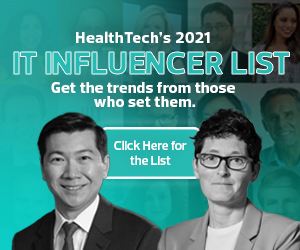The COVID-19 pandemic has pushed health IT leaders into the spotlight on internal, community and national issues guiding patient care, population health and equitable access.
“IT leaders are now business leaders. We are able to really stand out during this time in terms of leading change,” says David Chou, CIO of Harris Health System in Houston.
Dr. Atul Butte, chief data scientist at University of California Health (UC Health), says he realized that millions of people were turning to the university’s social media channels for pandemic information based on data his team was compiling daily. “I see my role as continuing to help the university use data to help our patients find the safest, most effective and cost-effective way to reach their best possible outcomes,” he says.
As the healthcare industry navigates these changing needs a year and a half into the pandemic, three of HealthTech’s 30 Healthcare IT Influencers Worth a Follow in 2021 reflect on how their roles have evolved and what the future of healthcare IT could look like.
Actionable Thought Leadership Is Needed for Health IT Adoption
Since 2020, Chou says, a 300-plus team has supported Harris Health’s workforce around-the-clock, onsite and offsite. He says deploying technology was easy, but remote work was an organizational culture change.
“Most healthcare facilities in the U.S. have never embraced a remote workforce. We’ve been forced out of that mentality,” Chou says. “But we’ve learned that many organizations have not experienced any performance issues, and some have seen an increase in activity. But it is a very different way of managing.”
Chou says his role has evolved to include not only finding IT solutions, but also galvanizing support for solutions across departments.
“We have to bring in solutions for the organization and bring disparate departments together to create the proper design for a solution,” Chou says. “At the same time, we also have influenced the organization in terms of adopting the right solution. A big part of my role now is just to educate, persuade and really bring together our community.”
Increased Transparency Is Key in Health Data Tracking
With an influx of information from a growing number of outlets, Butte says it’s up to healthcare organizations to be more transparent.
“We have seen how much the public needs to see actual data on what is happening in our hospitals, towns and country,” Butte says.
His team went from managing monthly updates for UC Health’s six academic health systems to reporting daily on public health outcomes since the start of the pandemic.
“We had to spin up daily data transfers from each of our hospital systems, reporting on testing, positive cases, hospitalizations, nightly census and, of course, patient disposition. These numbers were rapidly translated into dashboards, which were then emailed every morning to hundreds of individuals and teams,” says Butte, adding that the data collected was distributed statewide and to the White House.
Moving forward, Butte says it will be important to also track the health status of UC Health employees. He says the team is looking toward real-time analysis of health system utilization instead of daily tracking.
“We have now shown in the University of California that our systemwide umbrella can really help with finding the synergies across our academic health systems and quickly responding to statewide and national needs,” Butte says.
Prioritizing Equity and Access in Digital Health Solutions
The pandemic enabled Dr. Jennifer Joe, CEO of Vanguard.Health and chief ambassador of the Journal of Medical Internet Research, to expand conversations on equitable healthcare technology solutions. Since the pandemic, Joe has worked with the World Health Organization, the National Institutes of Health and other organizations to deliver digital solutions to healthcare.
“This has brought incredible pressure to create, innovate, deliver and communicate new solutions to the world,” says Joe, who also hosts the MedTech Insights talk show weekly on YouTube.
Joe says healthcare access has become the center of conversation for everyone across the globe.
“It’s also my belief that the early stages are the best time to ensure that new technologies and solutions deliver more equitable healthcare to everyone, irrespective of gender, sexual orientation, race, geographic location or socioeconomic status,” she says.
As a Chinese immigrant who grew up in rural Mississippi, Joe says her experiences drive her to find innovative solutions to create better healthcare access.
“I believe that I’ll have the most impact on healthcare delivery if I’m helping build the solutions,” she says. “Before the solution is finalized, I’ve asked the questions and pushed the team: Does this close the gap in providing equitable care? If not, what can we do better?”














